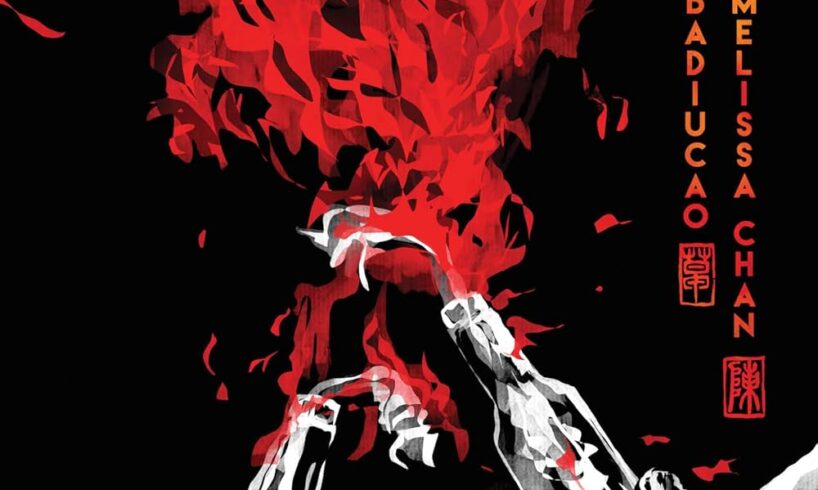
You Must Take Part in Revolution is a graphic novel by Badiucao, political cartoonist and former CDT contributor, and Melissa Chan, a journalist who in 2012 became the first reporter to be expelled from China in more than a decade. The book was conceived in the wake of the 2019 Hong Kong protests, and follows the divergent paths of three friends in Hong Kong and Taiwan from their involvement in the protests through to 2035.
CDT: I’m sure anyone reading CDT is familiar with each of you separately. How did the two of you come to join forces?
Melissa Chan: I’d interviewed Badiucao for a piece I wrote for The Atlantic about Chinese creatives in exile in Berlin. And then, during lockdown, I was back at my childhood home and my old bookshelf, re-reading my comic books and graphic novels. One day I just reached out to him and asked if he’d ever considered producing sequential art. It was just a passing thought—I didn’t know it would be the beginning of a five-year journey that would end with 260+ pages of a published graphic novel!
Badiucao: I’d always believed the comic and graphic novel forms had special powers to communicate messages. And I noticed there seemed to be a general gap in terms of content touching on China, human rights, and resistance. So I had the intention to produce something. That’s been on my mind a long time. But you need a good story, too. And then it felt very natural to team up with Melissa who is one of the best journalists to have covered China and who is also a great writer.
CDT: You come at this from very different professional angles. How did these complement each other? Were there differences that needed to be resolved, or that had to be left unresolved?
MC: This is a work of fiction, which made it a great sandbox to play in. I think our project would’ve been a far more difficult process if we’d decided to work on something non-fiction. Fundamentally, an activist and a journalist have different objectives, and I imagine there would’ve been a lot more conflict and disagreement about how to frame events or people.
BDC: Well, we respect each other so that made the collaboration easy. But of course, we think in very different ways. I believe art should convey a message. And the graphic novel form is a way to express things both visually and through storytelling. Art and words mutually support each other and by combining forces we can achieve something greater. But other times, the two collide and compete over the narrative. Sometimes, I feel the visual element is what we need. Other times, the text serves the moment and scene better. And that’s where we would negotiate and end up redrafting pages. But really, it has been a very smooth collaboration for these five years.
CDT: How (and at what point in the process) did you pick the title?
MC: Oof. There were some pretty bad ideas, and lists. Then I started browsing Mao Zedong’s writings, because I thought it’d be provocative and subversive to excerpt something he said. He was a true believer and earnest revolutionary before power corrupted him. And then I came across a line in this 1937 essay of his. It’s nothing famous—not one of his aphorisms—just a line, but it jumped out at me.
BDC: For me, it’s always fascinating how authoritarian regimes try to harness the power of language, and then they pollute the meaning of words and manipulate them. Thus, it’s a battle to win back the language, to fulfill its true meaning, or to expand the meaning of something because it is so important to do so. I think reclaiming the word “revolution” from the corruption of Mao Zedong—that has a purpose.
CDT: The book’s characters embody various forms of Chinese identity. How does this reflect your own backgrounds and experiences?
MC: One of the characters is Asian American and I am Asian American so that is an obvious connection. But the more complex answer is that I put everything I learned while reporting in China and thereafter into this work in different ways. For example, you might notice that all three characters are actually quite lonely people — something I noticed in Chinese dissidents I’ve interviewed over the years. Theirs is a hard path, and one most people wouldn’t want to walk along. So there was far less transposing of our respective identities into the characters and far more our general presence and experiences expressed in scenes, themes, and a myriad of other ways in this story.
BDC: The West tends to see the Chinese diaspora as one thing. But people from China, Hong Kong, Taiwan have very different understandings of the world. This translates into them possibly making very different choices when faced with the same struggle. This graphic novel explores three distinct perspectives: there is a character from China, another from Hong Kong, and another who grew up in America and returns to East Asia. They may all speak the same language, but their backgrounds set them on different life trajectories.
For me, naturally, Olivia as the character from China is the one I can relate to the most. She makes me think about the stereotype that Chinese people are not capable of having democracy, that they’re not able to shatter the cage of censorship and brainwashing by the Chinese Communist Party. And the character is about exploring the possibility for change, and whether there is any hope for someone with her background.
CDT: The book is generous with explanations of Chinese history and politics, both through dialogue and in footnotes. Who were you hoping to reach with this? How did you decide what to explain and what to leave as “Easter eggs”?
MC: Our editor and publisher had so many questions, especially in that first chapter, and we realized we needed to provide some signposts for those who were totally unfamiliar with China, Hong Kong, and Taiwan. After all, one aim of You Must Take Part in Revolution was precisely to reach beyond the “China watcher” circle of readers to others in the mainstream, from teens to adults. As for the “Easter eggs” — we have a ton of those, some for Hong Kongers, or for those who know China, or references to pop culture. Question for China Digital Times: Did you find me and Badiucao hidden in the pages yet? We both make Hitchcock-style cameos!
[CDT identified Badiucao, but failed to recognize Melissa Chan.]
CDT: The plot begins amid the 2019 protests in Hong Kong, and gradually moves from history into fiction. As a journalist, Melissa, how did you think about the risks of blurring the lines between the two?
MC: Plenty of journalists have ended up writing fiction, so I didn’t find this a particularly difficult ethical conundrum. There’s also an entire category of fiction that begins in the real world and bifurcates to an imagined future. The harder part for me was adopting the craft of fiction writing: After spending two decades obsessively digging up the facts, I found myself sitting in front of the computer with the task of literally making shit up. I felt as if I was producing lie after lie, which went against all my instincts. A screenwriter friend helpfully pointed out that it may be fiction, but I was still seeking the truth. Once I had that in mind, things became a little easier.
CDT: Badiucao, the art style here is quite distinct from the one we’re familiar with, though there’s definite continuity. I hesitate to say it’s “softer,” but it’s not the stark, sharp black-and-white we’ve seen from you before. Can you tell us about this choice?
BDC: There are two reasons to choose this particular style. From the cultural level, the texture that I employ references traditional Chinese painting techniques. Like I mentioned earlier, it is very important to take back our language. That extends to the vocabulary for visual expression. It is very important to take ownership of classical Chinese art forms after the Chinese government has manipulated it so much. The Chinese Communist Party claims to be the defender or promoter of Chinese culture, despite their historical, brutal destruction of our heritage. So, for me, it is almost an obligation to declare war against the contempt of Beijing by conveying how traditional Chinese forms should not be associated with propaganda, but can actually advocate for freedom.
And there’s also a personal reason. A lot of my work is guided by the woodcut prints of German Expressionist artist Käthe Kollwitz. It’s a very strong form: sharp and powerful. It is the perfect language for political cartooning with its very efficient way of communicating. But the price to pay to achieve such efficiency is that you lose some of the details, so I had to modify the style for You Must Take Part in Revolution. What I ended up with is something softer, but I think it helps with the story.
CDT: Your signature accent color is red: you memorably told us in a 2013 interview that “if you open the dazzling neon jacket, China’s complexion is nothing more than black and red. Red is blood, fear and violence. Black is iron, freezing nights, depression, despair, and the silent corners. It’s the cloth gag covering the screams. The country is like a giant meat grinder, a layer of fresh blood covering a layer of despair, new despair covering the layer of fresh blood, over and over again.” Can you talk about your use of color in this book?
BDC: Less is more in this book, and I did not adopt the full color palette of many comic books. I wanted to limit color and have it explode across certain scenes to underscore political themes or emotional expressions. Red is the color of Communist China, but also other authoritarian states such as the former U.S.S.R., and popular with fascists. And yellow symbolizes the Hong Kong protests, and resistance in general.
CDT: Do you agree with the character who says that to save people, you have to give up some of your humanity?
MC: Maybe? Sometimes?
BDC: I think humanity is not about being perfect morally, but humanity is to recognise the flaw of our essence, and to acknowledge the mistakes and crimes that we do for what we believe were originally noble or moral purposes. It’s easy to judge other people’s behaviors when we don’t have to make the decisions ourselves. And it’s our flaws and the struggle of the human condition that makes reconciliation eventually possible when we realize we are no better than others; we are just the same. And we can make mistakes.
CDT: What’s the public reception been like?
BDC: Most of our book tour was in the U.S. at this ambiguous time with Trump’s second presidency. With our book depicting America as a less democratic, more fascist country in the near future … Well, it was received very well in a way I didn’t expect, at least when we created it years ago. At book events, Americans would ask me what they can do to defend democracy? And here I am, a Chinese dissident artist who is still longing to one day maybe see China changed. It is a very absurd moment.
MC: Nothing gives me more joy than when my friends buy my book only to have their teens run off with the copy to read it first—this has happened a number of times, and they’ve even sent me photos of their kids totally engrossed in You Must Take Part in Revolution. So these are folks generally unfamiliar with issues involving the Chinese-speaking diaspora. On the opposite end of the spectrum, there’ve been Hong Kongers, Taiwanese, and Chinese who’ve read the book and have had very thoughtful things to say to us. They’re obviously able to pick up a lot more of the subtext. To see them appreciate the book is deeply touching.
CDT: The book is likely to introduce some fans of graphic novels to Chinese politics, but also some China watchers to graphic novels. Where would you suggest they go from here? (It reminded me of We Stand On Guard.)
BDC: I hope the book can reach diverse groups. I hope the book is not just about introducing China’s struggle to the people who are not familiar with it. I have confidence the book is creating a story that connects people on a universal human rights level where even if you don’t understand China or you’re not interested in China, that you still find yourself able to relate to the fates and tough choices these characters we created in the book end up facing.
MC: If you’re totally new to graphic novels, start with Art Spiegelman’s Maus about the Holocaust, and Marjane Satrapi’s Persepolis about the Iranian Revolution. These are two of the best-selling graphic novels of all time, translated into dozens of languages. They are global successes. I’d also try Alan Moore’s V for Vendetta. I make a few more recommendations in a list I pulled together for Electric Lit, “8 Graphic Novels About Authoritarianism,” which you should check out!
For more on You Must Take Part in Revolution, see earlier interviews at comics blog Smash Pages and the Center for Media at Risk.





